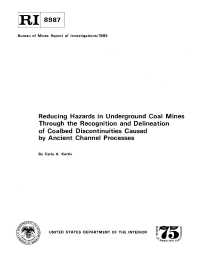Mining Publication: Reducing Hazards in Underground Coal Mines Through the Recognition and Delineation of Coalbed Discontinuities Caused by Ancient Channel Processes
Original creation date: January 1985
Because coalbed discontinuities often pose serious economic and safety problems in underground coal mines, criteria were documented for the recognition and prediction of discontinuities in advance of mining. Pennsylvanian strata in Indiana and Armstrong Counties, PA, were deposited as part of fluvio-deltaic complexes with channel- phase sandstones as the predominant type of coalbed discontinuity. Coalbed isopach maps constructed for this study delineated numerous want areas (areas of no coal) with elongate to linear geometries. A comparison of coalbed isopach and corresponding sandstone isolith maps of the study area revealed many examples of a thick-sandstone, thin-subjacent-coalbed relationship. Nearly 60 pct of the want areas in the study area were found to lie subjacent to thick (>20 ft [6 m]) sandstone accumulations. In addition to erosion of the coalbed, channels may contribute to coalbed splitting, coalbed thinning over paleotopographic highs, abnormal coalbed thicknesses, and deterioration of coal quality. If these features are considered, then approximately 80 pct of all interruptions in the economic coalbeds in this area result from channel activity. By using the criteria developed in this study and described in this Bureau of Mines report, the occurrence of coalbed discontinuities may be predicted and anticipated in advance of mining.
Authors: CA Kertis
Report of Investigations - January 1985
NIOSHTIC2 Number: 10004743
Pittsburgh, PA: U.S. Department of the Interior, Bureau of Mines, RI 8987, 1985 Jan; :1-23
See Also
- Probability of Encountering Coalbed Discontinuities During Vertical and Horizontal Borehole Drilling
- Progress Toward Improved Engineering of Seals and Sealed Areas of Coal Mines
- Refuge Alternatives in Underground Coal Mines
- Safe and Economical Inerting of Sealed Mine Areas
- SPONCOM - A Computer Program for the Prediction of the Spontaneous Combustion Potential of an Underground Coal Mine
- Technology News 535 - NIOSH Releases New Educational Video: Escape from Farmington No. 9: An Oral History
- Technology News 545 - NIOSH Updates Spontaneous Combustion Assessment Software
- Ultra-Low Frequency Through-the-Earth Communication Technology
- Wireless Mesh Mine Communication System
- Work Sampling Applied to a Human Factors Analysis of Mine Worker Positioning
- Content source: National Institute for Occupational Safety and Health, Mining Program


 ShareCompartir
ShareCompartir
